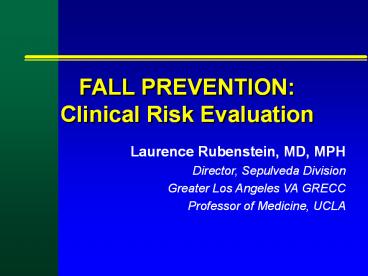FALLS IN OLD PEOPLE - PowerPoint PPT Presentation
Title:
FALLS IN OLD PEOPLE
Description:
Laurence Rubenstein, MD, MPH Director, Sepulveda Division Greater Los Angeles VA GRECC Professor of Medicine, UCLA Drugs & Falls: Meta-analysis Leipzig, Cumming ... – PowerPoint PPT presentation
Number of Views:390
Avg rating:3.0/5.0
Title: FALLS IN OLD PEOPLE
1
FALL PREVENTION Clinical Risk Evaluation
Laurence Rubenstein, MD, MPH Director, Sepulveda
Division Greater Los Angeles VA GRECC Professor
of Medicine, UCLA
2
(No Transcript)
3
Risk Factors for Falls 16 Multivariate Studies
Rubenstein LZ, Josephson KR. Clin Geriatr Med.
2002(May)18(2)141-158
4
Drugs Falls Meta-analysisLeipzig, Cumming,
Tinetti, JAGS, 1999
- Psychotropics, any 1.73 (1.52-1.97)
- Neuroleptics 1.50 (1.25-1.79)
- Sedative/hypnotics 1.54 (1.40-1.70)
- Antidepressants 1.66 (1.40-1.95)
- Benzodiazepines 1.48 (1.23-1.77)
- Diuretics 1.08 (1.02-1.16)
- Anti-arrhythmics (Ia) 1.59 (1.02-2.48)
- Digoxin 1.22 (1.05-1.42)
Leipzig RM, Cumming RG, Tinetti ME. J Am Geriatr
Soc. 1999(Jan)47(1)40-50
5
12-Month Fall Rate in NH Interacting Risk
Factors
Robbins AS, Rubenstein LZ, Josephson KR, et al.
Arch Intern Med. 1989(July)149(7)1628-1633
6
Fall Injury Risk Factors
- Risk Factors Signif/All
- Gait/balance deficit 3/6
- Cognitive deficit 3/6
- Female sex 3/6
- Vision deficit 2/6
- Medications 2/6
- Weakness 2/5
- ADL deficit 2/6
- Low body mass 2/6
- Higher activity 1/6
Rubenstein LZ, Josephson KR. Clin Geriatr Med.
2002(May)18(2)141-158
7
Fall Risk Assessment MeasuresPerell K, et al J
Gerontol Med Sci 2001.
- Review of 20 fall risk measures
- 14 nursing tools, 6 functional tools
- Common items for nursing tools
- mental status (13), fall hx (10), mobility (10),
other dx (8), incontinence (8), drugs (7),
sensory deficits (7), balance (5), age (4), ADLs
(4), assistive device (4), weakness (4), gender
(3), acuity (3), restraint use (1) - Best measures overall
- Hospital Oliver 97, Schmid 90, Morse 89,
Hendrick 95, Rapport 93 - Outpatient Shumway-Cook 00, Cwikel 98, Tinetti
86, Berg 89 - NH universal precautions (or Morse 89,
Shumway-Cook 00)
8
Fall Risk Assessment Measures The Reality
- Most can accurately identify patients at higher
risk of falls - Probably helpful to sensitize community living
elders of their fall risk what to do - Important for medico-legal purposes in hospitals
NHs You need to show youre doing something
that is organized and current. - But virtually all patients in hospital and NHs
come out as high risk.
9
Clinical Approach to the Faller
- Assess treat any injury
- Determine likely precipitating cause(s)
- history, physical , lab (limited)
- Prevent recurrence
- treat underlying cause/illness
- identify reduce risk factors (e.g., weakness,
gait/bal prob, visual prob, polypharm) - reduce environmental hazards
- teach adaptive behavior (e.g., slow rise, cane)
10
Falls History
- Circumstances prodrome of fall
- sudden LOC, sudden leg weakness,
tripped/slipped/hazard, position change, head
back, tight collar, cough/urination,
palpitations/angina, dizziness/giddiness - Major medical problems
- esp. cardiovascular, neurologic
- Drugs
- esp. psychoactive, cardiac, diuretic
11
Physical Exam Key Aspects
- Vital signs postural pulse/BP, temp
- HEENT vision, hearing, nystagmus
- Neck ROM, motion-induced vertigo, bruit
- Card/Pulm CHF, arrhythmia, murmur
- Extrems arthritis, ROM, deformities, feet
- Neuro altered MS, gait/balance deficit,
weakness, focal findings, tremor, rigidity,
peripheral neuropathy, divided attention
12
Lab/Diagnostic Tests
- CBC
- Blood glucose, Na, K, Ca, BUN
- X-ray of injuries
- ECG
- Holter monitor /or CSM (if syncope, arrhythmia,
or cardiac cause suspected) - Formal gait balance testing
13
Nursing Interventions
- Risk assessments (Morse, Hendrich, MDS)
- Treat identified risks
- Universal fall precautions
- call light assist devices close
- bed wheels w/c brakes locked
- adequate lighting
- clean spills immediately
- patient orientation staff educ
- For high-risk patients
- move closer to nursing station
- increased observation / sitter
- bed-chair alarms
- low beds
- non-skid slippers
- rails grab bars
- clutter-free rooms
- clear signage
- floor mats
- special careplans
- hip protectors
14
Evidence Based Guideline for Fall Prevention
(AGS-BGS-AAOS Task Force, 2001) SUMMARY
- Assessment
- Inquire about falls, gait, balance at routine
visits (at least annually). - Screen persons reporting a problem (e.g., get up
go test). - Assess persons failing screen, or w/ gt1 fall
- Hx of fall circumstances, meds, chronic illness,
mobility level - Examine gait, balance, orthostasis, vision,
neuro, cardiovascular - Management of Fallers
- Multi-component interventions assessment f/u,
exercise, gait training, med review,, treatment
(e.g., visual, cardiac, orthostasis) - LTC setting interventions assessment f/u,
staff education, gait training assistive
devices, medication review adjustment - Single interventions assessment f/u, exercise
(esp balance), environmental assmt/mod,
medication review adjustment
15
Assessment and Management of Falls
Periodic case finding in Primary Care Ask all
patients about falls in past year































